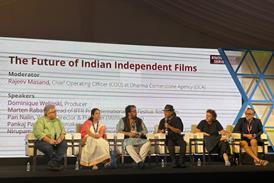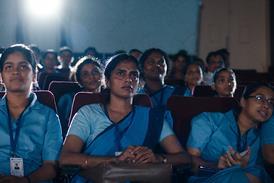BFI-backed productions must comply with new ‘three ticks’ rule from September.
UK film productions that receive money from the BFI Film Fund must adhere to new diversity quotas from September, the BFI has announced today.
The BFI’s new three ticks assessment - designed to improve diversity of ethnicity, disability, gender, sexual orientation and socio-economic background in the industry - requires applicants to demonstrate commitment across three areas of their production: on screen diversity, off-screen diversity and employment opportunities.
At least one ‘tick’ will be needed in two of the three areas for a project to be eligible for funding (full criteria and guidelines below).
Projects will be independently assessed by the BFI’s Certification Unit with qualifying films receiving a BFI diversity logo.
To incentivise good practice, each year one qualifying producer will be given a Lottery award to fund a diversity opportunity or work placement within their company for 12 months.
The BFI is also recruiting a diversity expert to support the implementation of the new guidelines and provide guidance to BFI-backed productions.
The approach, which is backed by UK producers’ association Pact and recruitment and training charity Creative Access, will be adapted and rolled out across all BFI Lottery funding for film by July 2015.
BFI Film Fund director Ben Roberts will introduce the measure today to a number of creative industries executives at a roundtable on diversity hosted by Creative Industries Minister Ed Vaizey.
Roberts commented: “The ‘three ticks’ approach incentivises good practice and helps to embed diversity across every area of a film’s production, whilst being flexible enough to allow productions to make positive choices. Ideally we want to see the industry embracing the three ticks approach to ensure that the most talented are able to progress and succeed, whatever their background.”
Vaizey said: “This initiative from the BFI should help raise the bar and ensure BFI lottery funded film productions reflect diversity both in front and behind the camera.
“I want to continue to see the TV, film and the performing arts industries actively discussing how they can drive change and improve diversity right across these sectors. I hope others will follow the BFI in developing and implementing possible solutions.”
Examples of recent Film Fund films that would get a tick for diversity of subject matter include Belle, Pride, Suffragette, The Selfish Giant, Philomena, Catch Me Daddy and Calvary.
The guidelines state that examples of people from ‘socially disadvantaged’ backgrounds can include “individuals who or whose parents and family live below the national average
wage; or whose parents were not university educated, or who were given free school meals”.
THE √√√ CRITERIA
| SECTION A: ON SCREEN DIVERSITY | ||
| A1 DIVERSE SUBJECT MATTER | Films where the narrative reflects diversity through the story and its characters. For example, where a film’s subject matter explicitly and predominantly explores issues of identity relating to ethnicity or national origins, a specific focus on women, people with disabilities, sexual identity, age and people from a socially disadvantaged background. Other factors relating to on screen diversity through subject matter: where the film attaches value to those aspects or dimensions of self and/or community identity in relation to religion or beliefs. Some examples of recent Film Fund films that meet these criteria include: BELLE, PRIDE, SUFFRAGETTE, GONE TOO FAR, THE SELFISH GIANT, PHILOMENA, X+Y, THE DUKE OF BURGUNDY, FOR THOSE IN PERIL, CATCH ME DADDY, CALVARY, 45 YEARS. | √ |
| A2 DIVERSE LEAD CHARACTERS | If at least 1 of the lead characters positively reflects diversity through ethnicity (BAME), disability, gender, sexual identity or people from a socially disadvantaged background. | √ |
| A3 PROMINENT ON SCREEN PORTRAYAL IN SUPPORTING & BACKGROUND CHARACTERS | If at least 30% of the supporting and/or non-speaking characters positively reflect diversity through ethnicity (BAME) or national origins , disability, gender, sexual identity or people from a socially disadvantaged background. | √ |
| SECTION B: OFF SCREEN DIVERSITY | ||
| B1 DIRECTOR; SCRIPTWRITER; COMPOSER; or CINEMATOGRAPHER | If the Director, Scriptwriter, Composer or Cinematographer is from a diverse background either through ethnicity (BAME), disability, sexual identity, gender (women) or from a socially disadvantaged background | √ |
| B2 HODs | At least 2 of the HoDs (Production Designer; Costume Designer; Lead Editor; Sound Designer; VFX supervisor; Hair & Make-up Supervisor) are from a diverse background, either through ethnicity (BAME), disability, sexual identity, gender or from a socially disadvantaged background. | √ |
| B3 CREW | At least 10% of the total crew are BAME; or 5% are disabled; or 40% are from a socially disadvantaged background; or if at least 30% are women; or, depending on the location of the production, we will also consider an otherwise demonstrable and reasonable ‘significant engagement’ | √ |
| B4 PRODUCTION COMPANY STAFF | If at least 10% of the applicant production company staff, including the producer/s, are from a diverse background either through ethnicity (BAME), disability, or from a socially disadvantaged background; or if at least 50% are female. | √ |
| SECTION C: CREATING BAME & DISABILITY OPPORTUNITIES AND PROMOTING SOCIAL MOBILITY | ||
| C1 PAID INTERNS / EMPLOYMENT OPPORTUNITIES | If the applicant production company engages one or more paid interns from a diverse background (specifically BAME or from a socially disadvantaged background) for no less than 6 months, from a programme such as Creative Access, or offers employment opportunities | √ |
| C2 TRAINING & SKILLS | In addition to the existing requirement to make a contribution to skills and training through the SIF levy payment, if the production or parent production company makes and offers at least one trainee placement for people from diverse backgrounds (specifically BAME or from a socially disadvantaged background) through Creative Skillset or other training placement programmes. | √ |
| C3 ONGOING PROGRESSION | If a production takes on a former C2 trainee, or a production company takes on a former C1 intern or employee, and moves them upwards into a more developed role. NB. As part of its industry wide diversity monitoring, the Film Fund Diversity Expert will look at the overall progression of interns and trainees and identify barriers to career development. | √ |
NB. One of the aims of the guidelines is to create opportunities for people from socially disadvantaged backgrounds and
individuals whose current socio-economic circumstances don’t provide them with the financial stability to progress in
the industry. For example, this might be individuals who or whose parents and family live below the national average
wage; or whose parents were not university educated, or who were given free school meals.
Download the BFI’s three ticks guidelines here: www.bfi.org.uk/filmfund

























3 Readers' comments